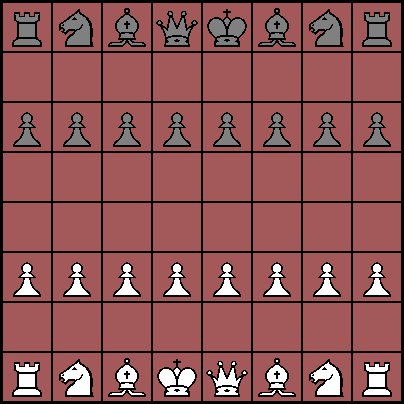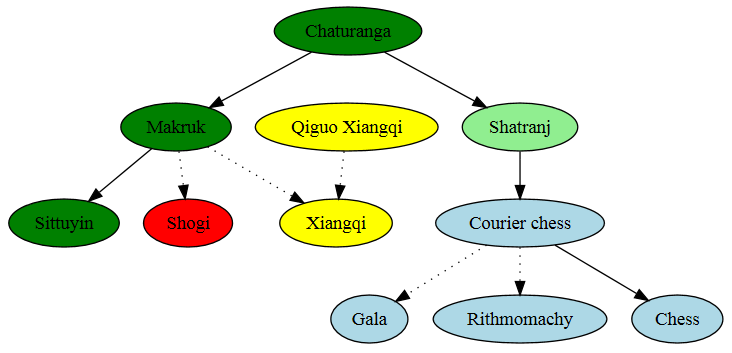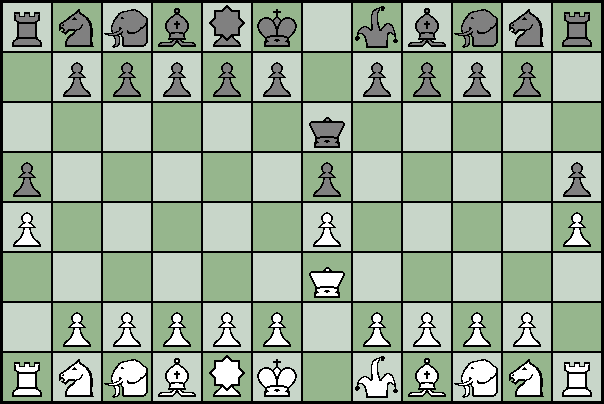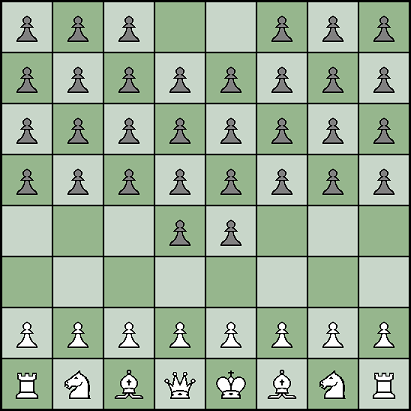Gift bag
 - The box! - Father Kabani barked and was silent for a long time, making strange movements with his cheeks ...
- The box! - Father Kabani barked and was silent for a long time, making strange movements with his cheeks ...
“A box ...” repeated Kabani’s father in a dropped voice. - This is what we say, as if we are inventing. In fact, everything has long been invented. Someone long ago invented everything, put everything in a box, turned a hole in the lid and left ... Gone to sleep ...
A. and B. Strugatsky " It's hard to be a god "
On the nose, New Year and time to give gifts. A lot has been done over the year. My project is growing before our eyes and, most importantly, getting smarter. How exactly he does it is a separate story, which I will definitely tell, somehow, another time. Now is the time to look into the bag and see what Dagaz has prepared for us.
I want to start my review with the great game of Trevor Truran "Whack ! ", Developed based on the work of the same name by everyone's favorite Terry Pratchett . From this game I began (seriously) to master the Zillions of Games . Now you can play it on the web . By the way, my son drew a board for the game (and I only edited it a little bit).

The picture is clickable (like all subsequent ones in the article). For me, "Bang!" Is good for its asymmetry. Trolling is pretty trivial. Coming up close, they kill everyone who is nearby. Dwarves, by contrast, have to work hard. They are more mobile and more of them, but in order to attack the troll (jump on it), they have to build a line. A dwarf who is on the edge can “jump back” by a number of steps not exceeding the size of the group assembled (trolls can jump in the same way).
In the modern world, board games are usually symmetrical, but in ancient times this was not the case. " Fox and Geese ", " Asalto ", " French War Game " - all these games are asymmetric (and were incredibly popular, at one time). Also asymmetrical are the games of the Tafl family, which have survived to this day thanks to the writings of Carl Linnaeus , as well as the irrepressible love of the Finnish people for various entertainments.
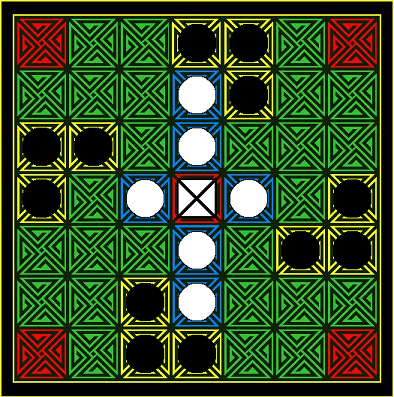
White needs to escort his king from the “throne” located in the center of the board to any of the corner fields. Their opponents are trying to prevent it from happening. Unlike similar games on large boards, all figures, and not just the king, can move just one step in any of the orthogonal directions. In all games of the family, the ancient form of cooperative seizure operates. In order to remove a piece from the board, it is necessary to surround it with its pieces from two sides (with one move, you can capture up to three pieces).
An empty “throne” and angular fields (which no pieces other than the king can enter) can also be used for capturing. Any piece can safely rise between two opponents (this situation is not considered a capture). When attempting to capture the king, White has the right to make another move (if this move does not remove one of the opponents who took the king into the environment, White counts for defeat). In addition, if the king is on the "throne" or next to him, it must be surrounded on all four sides.

Another game that was most likely influenced by Tafl. Medieval " Farm Chess ". The similarity with Chess , however, is rather remote. I already wrote about this game before . To win, you must hold two of their kings in the center of the board - "holy place." In general, I must say that Chess did not immediately become what we used to see them.
History with geography
It all started, perhaps, with Hashtapad - an Indian board, 8x8 fields, used for " combat races ". Games of this kind are common in India to this day, but the rules of Ashtapad itself, unfortunately, have been lost. It is clear only that the layout of the board itself is connected with this game. D4 bones (with four edges) were used to determine the range of the pieces in the game. The figures themselves should have been spiraling around the board to the center of the board.
At some point, on this basis, the difficult tactical game " Chaturanga " was born, dividing the figures into four types of troops (the name "Chaturanga" translates as "four-piece"). Somewhere on the net, I saw (and since then I can’t find it) an explanation of the course of the figures, based on the result of the roll of the bones (recall that the bones with four edges were used in the game).

The theory that Chess evolved from the game of four players is, apparently, erroneous . This version of the game is also found, but, most likely, appeared much later. In a two-player game, the king was supplemented by a “minister” who also moved only one field, but only in diagonal directions. Very weak and slow-moving figure.
The Persian " Shatranj " outwardly almost did not differ from "Chaturangi." The rules for the transformation of pawns have changed, but, most importantly, the concepts of shah and mate first appeared In Chaturang, it was necessary to capture or “bare” a raja (leave him without figures). In Shatranj, the Shah became an inviolable figure. It was forbidden to leave him under threat, and to win it was required to put him in a hopeless situation ( checkmate or stalemate ). Exposure of the king was considered a draw. Since, due to the total low-speed figures, the debuts in Shatranj were very slow, the tabia became widespread - they started playing with the positions specified by the players:
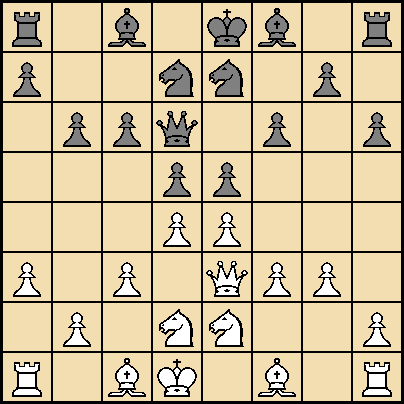
The next step on the way to Chess was the invention of the modern chess elephant in " Courier Chess " - a game of the XIII — XVIII centuries. The appearance of long-range figures moving along the diagonal led to the need to use the famous chess board marking, which in turn played a huge role in the development and distribution of Checkers . To play "Courier Chess", as a rule, also began with a kind of tabia:
After the invention of the long-range chess queen, the modern history of chess began. The latest changes in the rules were related to the addition of the rules of the " Castling ", pawns jump two squares forward, from the initial position and the associated rule of " taking on the aisle ". Regarding the latter, however, there is no complete clarity. In Malaysian Mine Chator there is a similar rule, but you can only take a pawn, which forward is blocked by another player’s pawn (this is strangely similar to cooperative capture in games of a “clamping” type, such as Tafl).
At some point, on this basis, the difficult tactical game " Chaturanga " was born, dividing the figures into four types of troops (the name "Chaturanga" translates as "four-piece"). Somewhere on the net, I saw (and since then I can’t find it) an explanation of the course of the figures, based on the result of the roll of the bones (recall that the bones with four edges were used in the game).
- " 1 " (in some sets of " 5 ") - Pawns and kings, moving just one step. The pawns moved “only forward” and (the only ones of the pieces) did not take it as they walked (one field forward, diagonally).
- " 2 " - Elephant (in some sources, "boat"). This figure is most confusing. Apparently, he initially walked into two cells in the orthogonal direction. Then the direction changed to a diagonal (there is another version of the movement, preserved in Thai " Makruk " - one cell in four diagonal directions or one cell forward, like the legs and trunk of an elephant). Moving into two cells, the elephant, like the chess knight we were used to, could “jump over” the pieces (in Indian combat races, the pieces jumped without blocking the movement).
- " 3 " - The horse moved three steps (two forward and one sideways). Such a bizarre way of moving is associated with the fact that in Ashtapad, performing a move in three steps, the figure quite often moved in this way (on turns). Of course, a horse, like an elephant, could jump over other figures.
- " 4 " - The Chariot (in some sources the elephant) is the most long-range figure. Moved to any number of cells in a straight line (in the orthogonal direction), but could not “jump over” other figures.

The theory that Chess evolved from the game of four players is, apparently, erroneous . This version of the game is also found, but, most likely, appeared much later. In a two-player game, the king was supplemented by a “minister” who also moved only one field, but only in diagonal directions. Very weak and slow-moving figure.
The Persian " Shatranj " outwardly almost did not differ from "Chaturangi." The rules for the transformation of pawns have changed, but, most importantly, the concepts of shah and mate first appeared In Chaturang, it was necessary to capture or “bare” a raja (leave him without figures). In Shatranj, the Shah became an inviolable figure. It was forbidden to leave him under threat, and to win it was required to put him in a hopeless situation ( checkmate or stalemate ). Exposure of the king was considered a draw. Since, due to the total low-speed figures, the debuts in Shatranj were very slow, the tabia became widespread - they started playing with the positions specified by the players:

Step aside
The problem of “leisurely debuts” in different countries was solved in different ways. For example, in the Ethiopian Senterej , the players simply started the game at the same time and moved the figures without paying attention to each other, right up to the first contact with the opponent (I must say that this is in good agreement with the African temperament). Perhaps the most innovative way to approach this issue is the Burmese .
In this game, which arose long before Fisher , only the order in which the pawns are placed is strictly regulated. The player is free to arrange the remaining pieces (on his / her side) as he pleases (well, except that the first line is always reserved for the rooks). This rule gives the game an incredible tactical variety and makes it almost useless to “memorize” various openings.
Closely related to Sittuyin is the Thai " Makruk ". Due to the fact that the transformation of pawns, in this game, takes place already on the sixth line (they all turn into the same weak “queen”), and the number of such transformations is not limited (unlike, for example, from Sittujna) the game in the endgame becomes very original and extremely interesting. The famous Soviet chess player and former world champion Vladimir Kramnik was seriously keen on this game. Here is what he said about her:
Most likely, it was Makruk that served as the basis for the Chinese and Japanese branches of the family of chess games. Of course, it is impossible to assert this with one hundred percent accuracy - these games have changed too much, but, in any case, the arrangement of pawns both in “ Syantsy ” and in “ Shogi ” most closely resembles the similar one in “Thai Chess”.
In this game, which arose long before Fisher , only the order in which the pawns are placed is strictly regulated. The player is free to arrange the remaining pieces (on his / her side) as he pleases (well, except that the first line is always reserved for the rooks). This rule gives the game an incredible tactical variety and makes it almost useless to “memorize” various openings.
Closely related to Sittuyin is the Thai " Makruk ". Due to the fact that the transformation of pawns, in this game, takes place already on the sixth line (they all turn into the same weak “queen”), and the number of such transformations is not limited (unlike, for example, from Sittujna) the game in the endgame becomes very original and extremely interesting. The famous Soviet chess player and former world champion Vladimir Kramnik was seriously keen on this game. Here is what he said about her:
Makruk is more strategic than chess, ... You have to plan combinations in a more general context. Thai makruk can be likened endgame in international chess.
Most likely, it was Makruk that served as the basis for the Chinese and Japanese branches of the family of chess games. Of course, it is impossible to assert this with one hundred percent accuracy - these games have changed too much, but, in any case, the arrangement of pawns both in “ Syantsy ” and in “ Shogi ” most closely resembles the similar one in “Thai Chess”.
The next step on the way to Chess was the invention of the modern chess elephant in " Courier Chess " - a game of the XIII — XVIII centuries. The appearance of long-range figures moving along the diagonal led to the need to use the famous chess board marking, which in turn played a huge role in the development and distribution of Checkers . To play "Courier Chess", as a rule, also began with a kind of tabia:
After the invention of the long-range chess queen, the modern history of chess began. The latest changes in the rules were related to the addition of the rules of the " Castling ", pawns jump two squares forward, from the initial position and the associated rule of " taking on the aisle ". Regarding the latter, however, there is no complete clarity. In Malaysian Mine Chator there is a similar rule, but you can only take a pawn, which forward is blocked by another player’s pawn (this is strangely similar to cooperative capture in games of a “clamping” type, such as Tafl).
Nowadays, the variations of this game are also striking in their diversity . Not all of them are equally interesting, but sometimes there are real pearls among them. For example, I really liked the options of the game with unequal armies .
Here all chess rules are followed (in any case, those that make sense, within the framework of the initial placement of figures). These games are well balanced and, in addition, can entertain those who are bored with the usual chess game. If, however, a simple change in the initial set-up is not enough, there are even bolder games that sweep all the templates in their path:
In the Platform Chess, all the chess rules we are used to are also observed (no need to retrain), but the very concept of the playing field - the transformer literally explodes the brain. For those who prefer board games to the good old puzzles, I prepared 60 levels of Sokoban (keyboard arrows work).
Happy New Year, everyone!
All Articles

